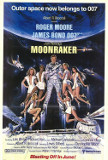Moonraker (United Kingdom, 1979)

Moonraker is a sort of James Bond meets Star Wars. Released in 1979, the year that saw the arrival of Star Trek on the big screen, Moonraker was the latest film to latch onto the science fiction revival started by George Lucas' 1977 picture. Audiences flocked to see Moonraker, making it the highest grossing 007 movie before Goldeneye. The mixture of escapist action and space shoot-outs found favor with the American public. Indeed, while parts of Moonraker are rather silly (a trend during Roger Moore's tenure), solid special effects, well-executed action sequences, and a strict reliance upon the "Bond Formula" keep this film among Moore's better entries as the British superspy.
Although promotional material for the film highlighted the outer space sequences, most of Moonraker takes place on Earth, in such diverse locations as California, Brazil, and Venice. Both Bond girls are residents of this planet, as well (007 has yet to bed an alien) -- Lois Chiles as Holly Goodhead, CIA operative and trained astronaut, and Corinne Clery as Corinne Dufour, the assistant to megalomaniac du jour Drax (Michael Lonsdale).
The film opens with the hijacking of a Moonraker space shuttle on loan from the United States to Great Britain. Anxious to get to the bottom of the situation, the British government sends agent 007 to investigate, beginning with Drax Industries in California, where the shuttle was produced. Bond arrives, starts poking around, and becomes the immediate target of several murder attempts. Along the way, he strikes up a relationship with Dr. Holly Goodhead, one of Drax's chief scientists, and encounters an old adversary -- Jaws (again played by Richard Kiel).
While Moonraker's centerpiece is the final half-hour, which takes place aboard an Earth-orbiting space station, this is actually the least entertaining portion of the film. It's essentially a special effects demonstration, with laser bolt shootouts and space shuttles firing at deadly satellites. Most of the tense action scenes occur before Bond blasts into outer space. If nothing else, this film proves that Bond is best on Earth.
Special note should be made of John Barry's score, his best since On Her Majesty's Secret Service. Barry weaves the familiar "James Bond theme" and "007 theme" into a rich musical tapestry whose main thread is the Moonraker title track. In addition, Barry uses an unusually diverse selection of musical cues, including the familiar theme from The Magnificent Seven and the five-note greeting from Close Encounters of the Third Kind.
Normally, characters in Bond films don't go through much development. Such is not the case with Jaws, however. One of 007's best adversaries returns for a second engagement (he was also in The Spy Who Loved Me). This time, however, the steel-toothed bad guy has mellowed as the direct result of falling in love. Although Jaws is still as indestructible as ever, we see a different side of him as Moonraker draws to a close. Just don't expect anything too dramatic -- this is still a James Bond movie, after all.
Moonraker marked Bernard Lee's final appearance as M. The actor died while preparing for the next Bond film, For Your Eyes Only. No M since has matched Lee's interpretation, and only with his passing did it become apparent how important this minor character is to the 007 adventures.
As Roger Moore's fourth Bond outing, and the eleventh film in the series, Moonraker is a satisfying followup to The Spy Who Loved Me. Science fiction fans may be offended by some of the liberties taken here, but tolerance is necessary. The film is, after all, geared towards a specific audience. Accent the "fiction" in science fiction, and recognize that with Bond, realism is the last thing anyone expects -- or wants.
Moonraker (United Kingdom, 1979)
Cast: Roger Moore, Lois Chiles, Michael Lonsdale, Richard Kiel, Corine Clery, Bernard Lee, Desmond Llewelyn, Lois Maxwell
Screenplay: Christopher Wood based on the novel by Ian Fleming
Cinematography: Jean Tournier
Music: John Barry
U.S. Distributor: United Artists
U.S. Release Date: -
MPAA Rating: "PG" (Violence, Sexual Situations)
Genre: ACTION/THRILLER
Subtitles: none
Theatrical Aspect Ratio: 2.35:1
- Spy Who Loved Me, The (1969)
- For Your Eyes Only (1969)
- (There are no more better movies of Roger Moore)
- (There are no more better movies of Lois Chiles)
- (There are no more worst movies of Lois Chiles)
- Munich (2005)
- (There are no more better movies of Michael Lonsdale)
- Goya's Ghosts (2007)
- Last Mistress, The (2008)
- (There are no more worst movies of Michael Lonsdale)
Comments